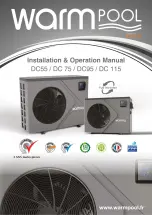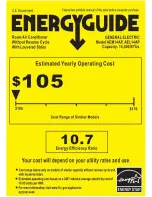
4
UT66000455 - 01
PWN
È severamente vietata la riproduzione anche parziale di questo manuale / All copying, even partial, of this manual is strictly forbidden
DECLARATION OF CONFORMITY
Galletti S.p.A., whose main office is in Via Romagnoli, 12/a Bentivoglio (BO)
- Italy, hereby declares, under its sole responsibility, that the
PWN
duct
units, devices for air conditioning systems, suitable for duct type air
distribution installations, conform to the specifications of EEC Directives
2006/42/CE - 2004/108/CE - 2006/95/CE
Bologna, 27/05/2010
Luca Galletti
President
1
BEFORE INSTALLATION
Carefully read this manual
Installation and maintenance may be carried out solely by qualified technicians
specifically trained for this type of equipment, in conformity with current regulations.
On receiving the equipment, check that it has not undergone any damage during
transport. For installation and use of accessories, please refer to the relative technical
sheets.
2
INTENDED USE AND OPERATING LIMITS
Galletti S.p.A. will not accept any liability for damage or injury caused as a result of:
nstallation by non-qualified personnel; improper use or use in conditions not allowed
by the manufacturer; failure to perform the maintenance prescribed in this manual;
use of spare parts other than original factory parts. The operating limits are specified
at the end of this chapter; usage outside the stated limits is to be considered improper.
Store the unit in its packing container until you are ready to install it to prevent dust
from infiltrating inside it.
During wintertime periods of quiescence, drain water from the system, to prevent
ice from forming. If anti-freeze solutions are used, check for their freezing point.
Do not attempt to modify the internal wiring or other parts of the unit.
Thermal carrier fluid:
water
Water temperature:
+ 5°C to +95°C
Air temperature:
-20°C to +40°C
Supply voltage:
230 V+/-10 %
Max. primary fluid pressure
10 bar
3
UNIT DESCRIPTION
The new range of PWN duct units has been designed to air condition rooms where
the ceiling recess installation of duct units is required. Main components:
Bearing structure
built from thick galvanised steel sheet, insulated with sound
proof/condensation proof, self-extinguishing material in Class 1. The unit has
slots for installation and 4 rubber vibration dumpers to reduce propagation of
vibrations.
Electric fan module
with single, double or triple double suction
centrifucal fan,
with statically and dynamically balanced blades, directly mounted on a 7 speed
electric motor, with permanently activated capacitor and thermal protection.
Wiring box
on the hydraulic connection side in order to reduce installation
clearance requirements. Electric connection by means of
screw terminal
block.
High efficiency, 3, 4 or 6 row
heat exchanger module
with copper piping and
aluminium fins blocked to pipings by mechanical expansion. It is equipped with
brass manifolds and vent valve. The heat exchanger usually comes with water
connections mounted on the left, but it can be turned by 180°.
Capacious drip tray
extending beyond the plumbing connections, enabling
collection of condensate from adjustment valves where present; the off-centre
position considerably reduces the space required for installation.
Air filter made
of acrylic fibre, filtration class G2, applied on the air intake; may
be pulled out from below
FIGURE 1-
example of installation
SM
Motor driven external air intake louver
SIL
Plenum silencer for air intake/outlet
PWN
Duct unit
MDF
Additional heat exchanger module for hot water operation
PMAC
Insulated air outlet plenum with Ø 200 collars
4
DIMENSIONS
FIGURE 2 PWN unit:
1
Water outlet, ¾" female gas
2
water inlet, ¾" female gas
3
Electric box
4
Electric supply cable holder
5
Water drip system, Ø 17 mm
FIGURE 3 air filter
5
INSTALLATION
WARNING: Install the duct unit, circuit breaker (IL) and/or any remote
controls in a place out of reach of persons who may be taking a bath or shower.
FIGURE 4 - exploded view of the unit
1.
Water drip tray
2.
Heat exchanger module
3.
Electric box
4.
Terminal board
5.
Vibration damper
6.
7 speed electric motor
7.
Fan drive assembly
It is advisable to install any accessories on the standard unit prior to positioning the
latter, making reference to the technical sheets. . The air intake and outlet have a
rectangular cross-section, with pre-cut holes for fastening the available accessories.
To make
connection using rectangular ducts
it is recommended to use
accessories
RD
or
RDC
, which can be fitted respectively on the intake or outlet
section.
NOTE
: to install ducts on both the inlet and outlet sides, you will need
1 RD
accessory (intake) and
1 RDC
accessory (outlet).
If you wish to make the connections using flexible circular ducts (Ø 200), it will
be necessary to use accessories
PMA
ot
PMAC
, which can be fitted respectively
on the intake or outlet section.
NOTE
: to install
flexible ducts (Ø 200),
on both the inlet and outlet sides, you
will need
1 PMA
accessory (intake) and
1 PMAC
accessory (outlet).
The exchanger connections can be switched over to the opposite side by carrying
out the following steps (FIGURE 5):
-
Remove the drip tray
-
Remove the exchanger module by taking out the fastening screws (2 per side
+ 3 on the upper part) and 2 in the lower part
-
Turn the exchanger module 180° (on the vertical axis) and screw it back onto the
fan module.
-
Adjust the position of the drip tray so that the projecting part extends below the
plumbing connection and fasten it in place
MOUNTING the unit
Insert the vibration dampers provided in the 4 slots indicated for ceiling installation.
Fasten the base unit to the ceiling or wall using at least 4 of the 8 slots provided.
It is recommended to use 8MA threaded bars plus screw anchors of adequate
capacity to bear the weight of the unit, and to prepare the positioning of the unit
using 3 8MA bolts (2 in the lower part, 1 in the upper part as shown in
FIGURE
6
) and two washers for each bar
Before tightening the lock nut, adjust the main nut so as to assure that the unit
is properly inclined so as to facilitate condesate drainage (
FIGURE 7
).
To obtain the proper inclination, tilt the unit so that the intake side is slightly lower
(approximately 10 mm) than the outlet side. Make the plumbing connections
to the heat exchanger and, where the cooling function is to be used, to the
condensate drainage outlet.
Use one of the two tray drain outlets, which can be seen on the outside of the
unit side panels.
To connect the unit to the drainage line, use a flexible rubber hose and secure
it to the pre-selected drain pipe (Ø 3/8'') using a metal clamp (use the drain outlet
situated on the plumbing connection side).
To favour the drainage of condensate, the drain hose should be inclined
downward, at least 30 mm/m; make sure that no loops or bends form along its
path.
Carefully read
this manual
WARNING
DANGER
LIVE PARTS
SAFETY SYMBOLS





































